Discover 35 hidden attractions, cool sights, and unusual things to do in Mexico City (Mexico). Don't miss out on these must-see attractions: Museo Nacional de Antropología, Chapultepec Castle, and Museo Soumaya. Also, be sure to include Palacio Nacional in your itinerary.
Below, you can find the list of the most amazing places you should visit in Mexico City (Distrito Federal).
Table of Contents
Museo Nacional de Antropología
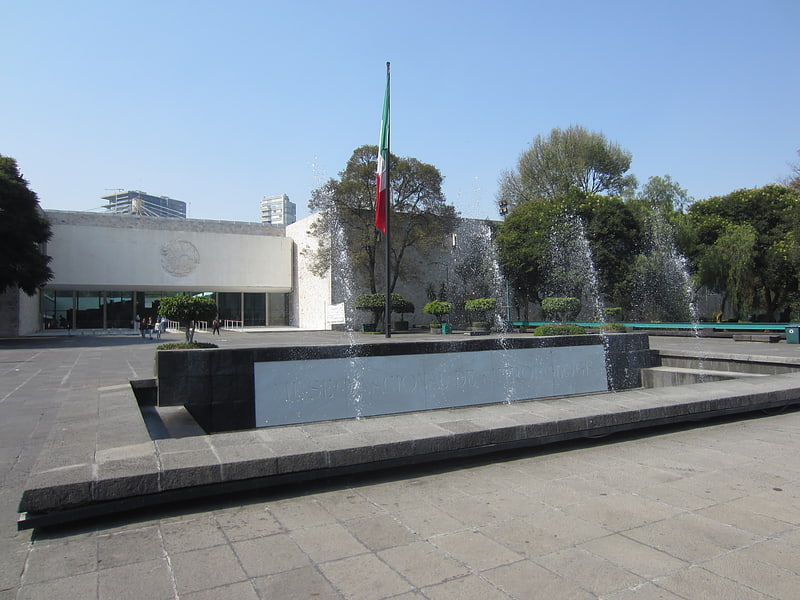
Museum with Mayan artifacts . The National Museum of Anthropology is a national museum of Mexico. It is the largest and most visited museum in Mexico. Located in the area between Paseo de la Reforma and Mahatma Gandhi Street within Chapultepec Park in Mexico City, the museum contains significant archaeological and anthropological artifacts from Mexico's pre-Columbian heritage, such as the Stone of the Sun and the Aztec Xochipilli statue.
The museum (along with many other Mexican national and regional museums) is managed by the Instituto Nacional de Antropología e Historia (National Institute of Anthropology and History), or INAH. It was one of several museums opened by Mexican President Adolfo López Mateos in 1964.
Assessments of the museum vary, with one considering it "a national treasure and a symbol of identity. The museum is the synthesis of an ideological, scientific, and political feat." Octavio Paz criticized the museum's making the Mexica (Aztec) hall central, saying the "exaltation and glorification of Mexico-Tenochtitlan transforms the Museum of Anthropology into a temple."[1]
Address: Av. Paseo de la Reforma s/n, 11560 Miguel Hidalgo (Miguel Hidalgo)
Chapultepec Castle

Also known as: Castillo de Chapultepec
Hilltop castle housing a history museum. Chapultepec Castle is located on top of Chapultepec Hill in Mexico City's Chapultepec park. The name Chapultepec is the Nahuatl word chapoltepēc which means "on the hill of the grasshopper". The castle has such unparalleled views and terraces that explorer James F. Elton wrote they “can't be surpassed in beauty in any part of the world." It is located at the entrance to Chapultepec Park at a height of 2,325 meters above sea level. The site of the hill was a sacred place for Aztecs, and the buildings atop it have served several purposes during its history, including that of Military Academy, Imperial residence, Presidential residence, observatory, and since the 1940s, the National Museum of History. Chapultepec Castle, along with Iturbide Palace, also in Mexico City, are the only royal palaces in North America.
It was built during the Viceroyalty as a summer house for the highest colonial administrator, the viceroy. It was given various uses, from the gunpowder warehouse to the military academy in 1841. It became the official residence of Emperor Maximilian I and his consort Empress Carlota during the Second Mexican Empire (1864–67). In 1882, President Manuel González declared it the official residence of the President. With few exceptions, all succeeding presidents lived there until 1939, when President Lázaro Cárdenas turned it into a museum.[2]
Address: Bosque de Chapultepec 1a Sección, 11580 Miguel Hidalgo (Miguel Hidalgo)
Museo Soumaya
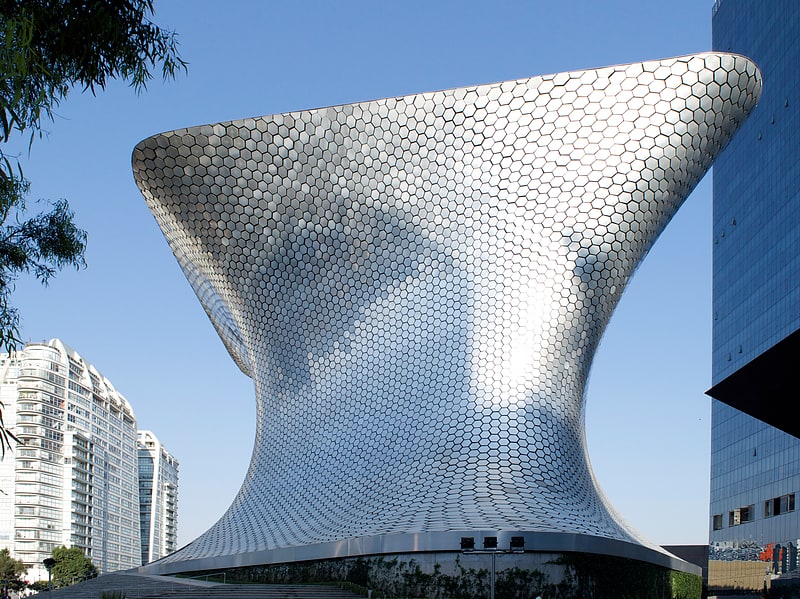
Art museum with many European works. The Museo Soumaya is a private museum in Mexico City and a non-profit cultural institution with two museum buildings in Mexico City — Plaza Carso and Plaza Loreto. It has over 66,000 works from 30 centuries of art including sculptures from Pre-Hispanic Mesoamerica, 19th- and 20th-century Mexican art and an extensive repertoire of works by European old masters and masters of modern western art such as Auguste Rodin, Salvador Dalí, Bartolomé Esteban Murillo and Tintoretto. It is called one of the most complete collections of its kind.
The museum is named after Soumaya Domit, who died in 1999, and was the wife of the founder of the museum Carlos Slim. The museum received an attendance of 1,095,000 in 2013, making it the most visited art museum in Mexico and the 56th in the world that year. In October 2015, the museum welcomed its five millionth visitor. The museum was designed by Fernando Romero's practice, fr·ee.[3]
Address: Blvd. Miguel de Cervantes Saavedra S/N, 11529 Ciudad de México (Miguel Hidalgo)
Palacio Nacional
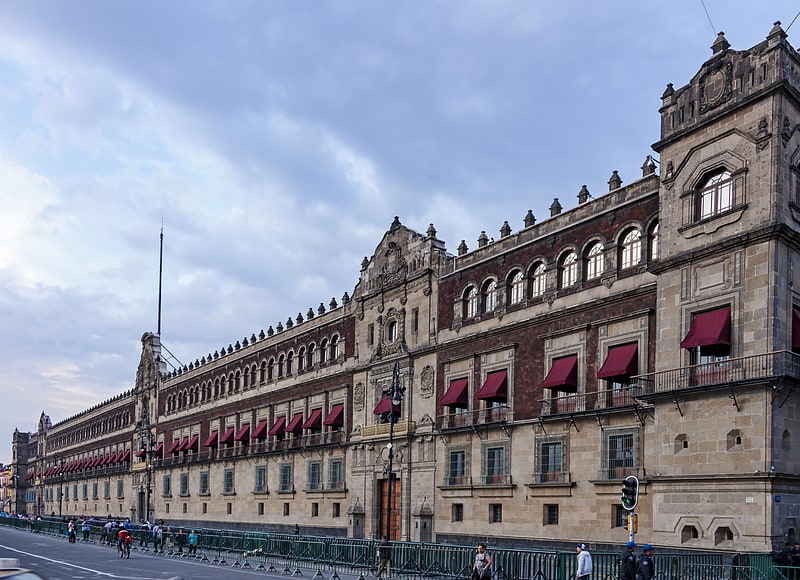
Palace with government offices. The National Palace is the seat of the federal executive in Mexico. Since 2018 it has also served as the official residence for the President of Mexico. It is located on Mexico City's main square, the Plaza de la Constitución. This site has been a palace for the ruling class of Mexico since the Aztec Empire, and much of the current palace's building materials are from the original one that belonged to the 16th-century leader Moctezuma II.[4]
Address: Avenida Pino Suarez, Corregidora esquina Guatemala, 06060 Mexico City (Cuauhtémoc)
Templo Mayor
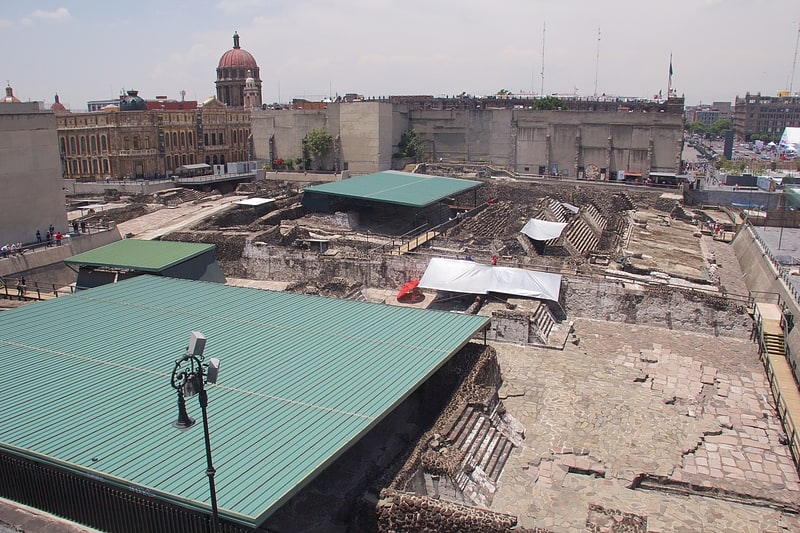
Museum dedicated to the Aztecs. The Templo Mayor was the main temple of the Mexica people in their capital city of Tenochtitlan, which is now Mexico City. Its architectural style belongs to the late Postclassic period of Mesoamerica. The temple was called the Huēyi Teōcalli in the Nahuatl language. It was dedicated simultaneously to Huitzilopochtli, god of war, and Tlaloc, god of rain and agriculture, each of which had a shrine at the top of the pyramid with separate staircases. The spire in the center of the adjacent image was devoted to Quetzalcoatl in his form as the wind god, Ehecatl. The Great Temple devoted to Huitzilopochtli and Tlaloc, measuring approximately 100 by 80 m at its base, dominated the Sacred Precinct. Construction of the first temple began sometime after 1325, and it was rebuilt six times. The temple was destroyed by the Spanish in 1521 to make way for the new Mexico City cathedral.
The Zócalo, or main plaza of Mexico City today, was developed to the southwest of this archeological site, which is located in the block between Seminario and Justo Sierra streets. The site is part of the Historic Center of Mexico City, which was added to the UNESCO World Heritage List in 1987. It received 801,942 visitors in 2017.[5]
Address: Seminario 8, 06060 Ciudad de México (Cuauhtémoc)
Palacio de Bellas Artes
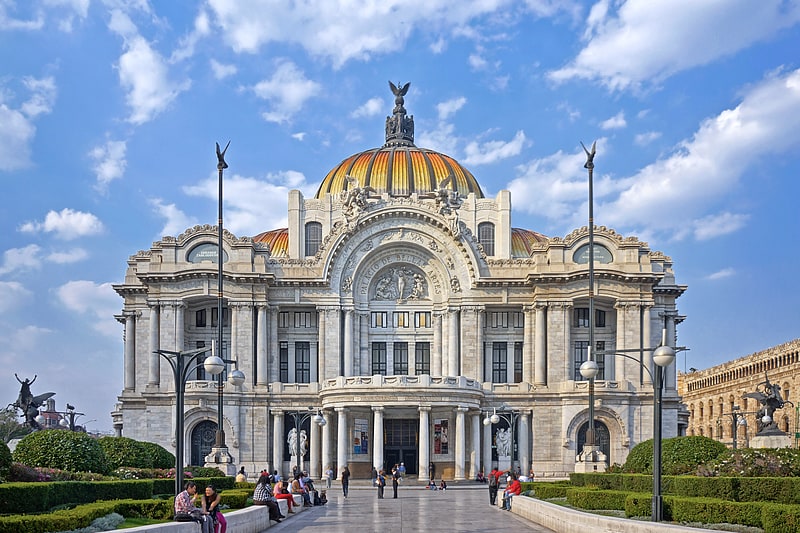
Opulent building dedicated to fine arts. The Palacio de Bellas Artes is a prominent cultural center in Mexico City. It has hosted notable events in music, dance, theatre, opera and literature in Mexico and has held important exhibitions of painting, sculpture and photography. Consequently, the Palacio de Bellas Artes has been called the "Cathedral of Art in Mexico". The building is located on the western side of the historic center of Mexico City next to the Alameda Central park.
The first National Theater of Mexico was built in the late 19th century, but it was soon decided to tear this down in favor of a more opulent building in time for Centennial of the Mexican War of Independence in 1910. The initial design and construction was undertaken by Italian architect Adamo Boari in 1904, but complications arising from the soft subsoil and the political problem both before and during the Mexican Revolution, hindered then stopped construction completely by 1913. Construction began again in 1932 under Mexican architect Federico Mariscal and was completed in 1934. It was then inaugurated on November 29 1934 and was the first art museum in Mexico dedicated to exhibiting artistic objects for contemplation.
The exterior of the building is primarily Art Nouveau and Neoclassical and the interior is primarily Art Deco. The building is best known for its murals by Diego Rivera, Siqueiros and others, as well as the many exhibitions and theatrical performances it hosts, including the Ballet Folklórico de México.[6]
Address: Av. Juárez 1, 06050 Cuahtemoc (Cuauhtémoc)
Mexico City Metropolitan Cathedral
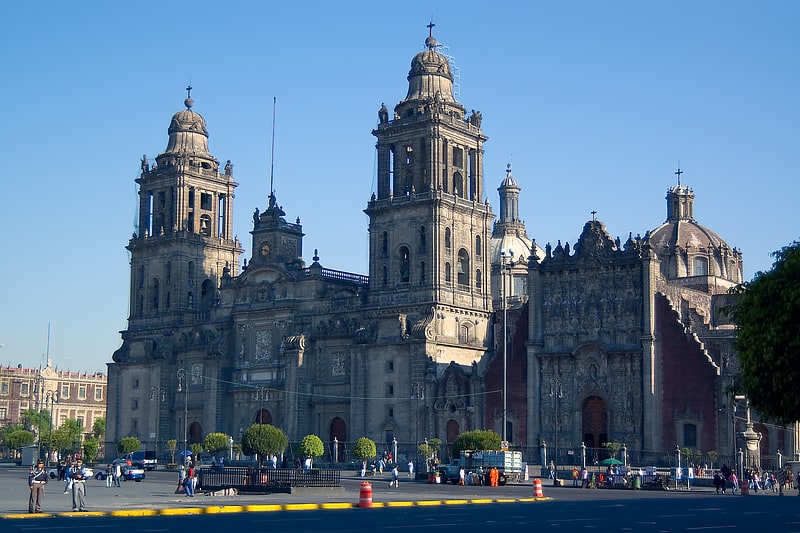
Also known as: Catedral metropolitana de la Ciudad de México
Grand cathedral with a storied past. The Metropolitan Cathedral of the Assumption of the Most Blessed Virgin Mary into Heaven is the cathedral church of the Roman Catholic Archdiocese of Mexico. It is situated atop the former Aztec sacred precinct near the Templo Mayor on the northern side of the Plaza de la Constitución in the historic center of Mexico City. The cathedral was built in sections from 1573 to 1813 around the original church that was constructed soon after the Spanish conquest of Tenochtitlan, eventually replacing it entirely. Spanish architect Claudio de Arciniega planned the construction, drawing inspiration from Gothic cathedrals in Spain.
Due to the long time it took to build it, just under 250 years, virtually all the main architects, painters, sculptors, gilding masters and other plastic artists of the viceroyalty worked at some point in the construction of the enclosure. The long construction time also led to the integration of a number of architectural styles in its design, including the Gothic, Baroque, Churrigueresque, Neoclassical styles, as they came into vogue over the centuries. It furthermore allowed the cathedral to include different ornaments, paintings, sculptures and furniture in its interior. The project was a point of social cohesion, because it involved so many generations and social classes, including ecclesiastical authorities, government authorities, and different religious orders.
The influence of the Catholic Church on public life has meant that the building was often the scene of historically significant events in New Spain and independent Mexico. These include the coronation of Agustín de Iturbide and Ana María Huarte as emperors of Mexico by the President of the Congress; the preservation of the funeral remains of the aforementioned emperor; burial, until 1925, of several of the independence heroes, such as Miguel Hidalgo y Costilla and José María Morelos; the disputes between liberals and conservatives caused by the separation of the church and the state in the Reform; the closure of the building in the days of the Cristero War; and the celebrations of the bicentennial of independence, among others.
The cathedral faces south. It is approximately 59 metres (194 ft) wide by 128 metres (420 ft) long, with a height of 67 metres (220 ft) to the tip of the towers. It consists of two bell towers, a central dome, and three main portals. It has four façades which contain portals flanked with columns and statues. It has five naves consisting of 51 vaults, 74 arches and 40 columns. The two bell towers contain 25 bells. The tabernacle, adjacent to the cathedral, contains the baptistery and serves to register the parishioners. There are five large, ornate altars, a sacristy, a choir, a choir area, a corridor and a capitulary room. Fourteen of the cathedral's sixteen chapels are open to the public. Each chapel is dedicated to a different saint or saints, and each was sponsored by a religious guild. The chapels contain ornate altars, altarpieces, retablos, paintings, furniture and sculptures. The cathedral is home to two of the largest 18th-century organs in the Americas. There is a crypt underneath the cathedral that holds the remains of many former archbishops. The cathedral has approximately 150 windows.
Over the centuries, the cathedral has suffered damage. A fire in 1967 destroyed a significant part of the cathedral's interior. The restoration work that followed uncovered a number of important documents and artwork that had previously been hidden. Although a solid foundation was built for the cathedral, the soft clay soil it is built on has been a threat to its structural integrity. Dropping water tables and accelerated sinking caused the structure to be added to the World Monuments Fund list of the 100 Most Endangered Sites. Restoration working beginning in the 1990s stabilized the cathedral and it was removed from the endangered list in 2000.[7]
Address: Plaza de la Constitución S/N, 06000 Ciudad de México (Cuauhtémoc)
Casa de los Azulejos
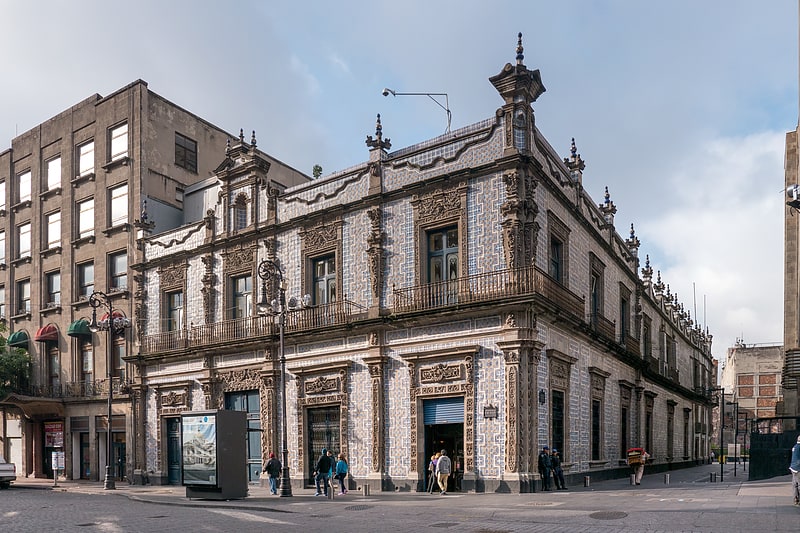
Palace known for its tile facade. The Casa de los Azulejos or "House of Tiles" is an 18th-century Baroque palace in Mexico City, built by the Count of the Valle de Orizaba family. The building is distinguished by its facade, which is covered on three sides by blue and white tile of Puebla state. The palace remained in private hands until near the end of the 19th century. It changed hands several times before being bought by the Sanborns brothers who expanded their soda fountain/drugstore business into one of the best-recognized restaurant chains in Mexico. The house today serves as their flagship restaurant.
The counts of the Valle de Orizaba began construction of the palace in the 16th century. Descendants of this House of Orizaba covered the exterior of the palace in 1737 with the beautiful azulejos that are seen today.[8]
Address: Francisco I. Madero 4, 06500 Ciudad de México Mexico City (Cuauhtémoc)
Reforma 222
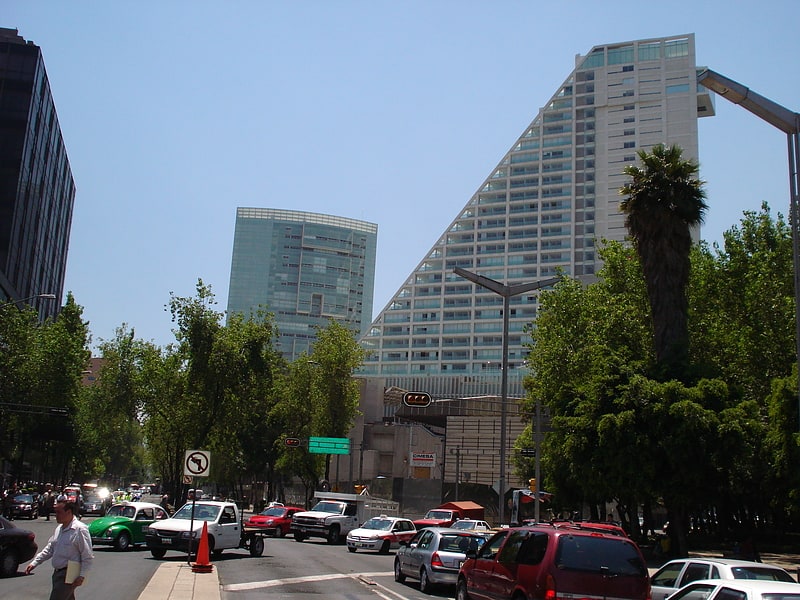
Shopping center in Mexico City, Mexico. Reforma 222 is a mixed-use complex on Paseo de la Reforma just west of Avenida de los Insurgentes in the Colonia Juárez neighborhood of Mexico City. Construction started in 2004; the complex opened in November 2007 and consists of three towers designed by Mexican architect Teodoro González de León, who also designed the National Auditorium and Museo Rufino Tamayo. There is 173,000-square-metre of space and there is a glass-covered shopping center.
Towers 1 and 2 rank among the top 30 tallest buildings in Mexico City. The height of the towers is as follows:
- Tower 1: 125.8m, 31 stories, offices
- Tower 2: 125.8m, 26 stories, residential
- Tower 3: 93.4m, 19 floors
Address: Mexico City, Paseo de la Reforma 222, colonia Juárez
Chapultepec
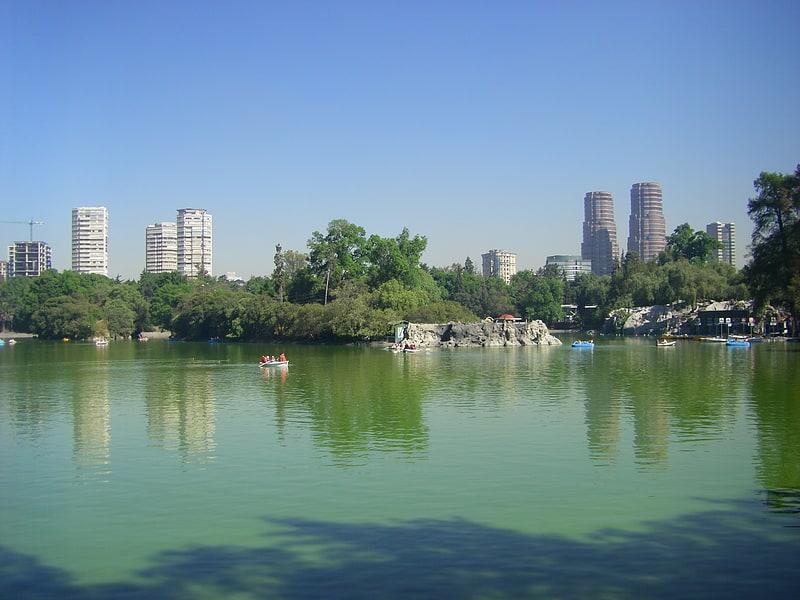
Expansive park with various attractions. Chapultepec, more commonly called the "Bosque de Chapultepec" in Mexico City, is one of the largest city parks in the Western Hemisphere, measuring in total just over 686 hectares. Centered on a rock formation called Chapultepec Hill, one of the park's main functions is as an ecological space in Greater Mexico City. It is considered the first and most important of Mexico City's "lungs".
The area encompassing modern-day Chapultepec has been inhabited and considered a landmark since the pre-Columbian era, when it became a retreat for Aztec rulers. In the colonial period, Chapultepec Castle was built here, eventually becoming the official residence of Mexican heads of state. It would remain so until 1940, when it was moved to another part of the park called Los Pinos.
Bosque de Chapultepec is divided into four sections, with the first section being the oldest and most visited. This section contains most of the park's attractions, including the castle, the Chapultepec Zoo, the Museum of Anthropology, and the Rufino Tamayo Museum, among others. It receives an estimated 15 million visitors per year. This prompted the need for major rehabilitation efforts that began in 2005 and ended in 2010. The government has authorized the construction of business, offices, and big parking lots for cars.[10]
Planetario Luis Enrique Erro
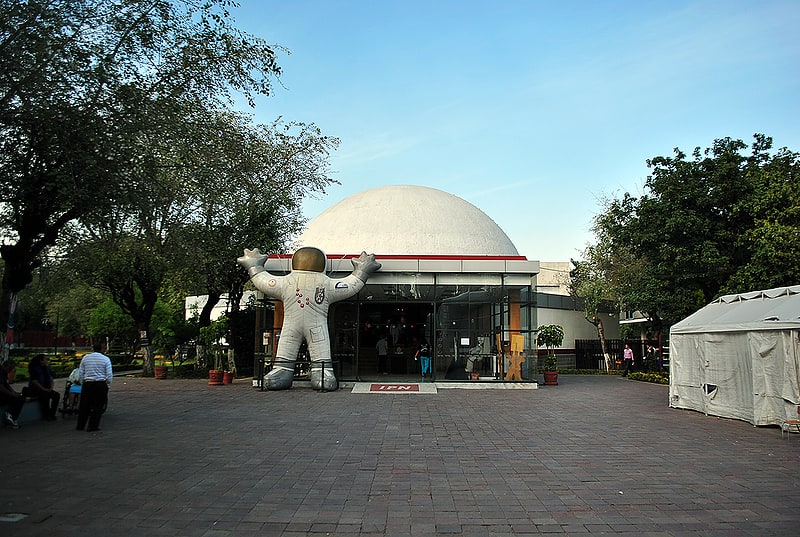
Museum in Mexico City, Mexico. Planetario Luis Enrique Erro is a planetarium located in Mexico City, owned and operated by the National Polytechnic Institute. It was the first planetarium in Mexico open to the public and is one of the oldest in Latin America. It was opened in 1967 and operated for over 39 years with a planetarium projector model Mark 4.
It was reopened to the public on 15 January 2007 after renovation and modernization costing about 43 million pesos. Its innovations include a stellar dome and new digital projection systems Digistar 3 provided by E&S through Ecosistemas de México, audio, acoustics and lighting.[11]
Address: Av. Wilfrido Massieu s/n, 07738 Ciudad de México (Gustavo A Madero)
Cuicuilco

Archaeological site in Mexico City, Mexico. Cuicuilco is an important archaeological site located on the southern shore of Lake Texcoco in the southeastern Valley of Mexico, in what is today the borough of Tlalpan in Mexico City. The settlement goes back to 1400 BC.
Cuicuilco flourished during the Mesoamerican Middle and Late Formative (c. 700 BCE – 150 CE) periods.
Today, it is a significant archaeological site that was occupied during the Early Formative until its destruction in the Late Formative. Based on its date of occupation, Cuicuilco may be the oldest city in the Valley of Mexico and was roughly contemporary with, and possibly interacting with, the Olmec of the Gulf Coast of lowland Veracruz and Tabasco (also known as the Olmec heartland).[12]
Address: Calle Zapote Espacio Ecologico Cuicuilco 11, 14060 Mexico City
Monumento a la Independencia

Iconic War of Independence monument. The Angel of Independence, most commonly known by the shortened name El Ángel and officially known as Monumento a la Independencia, is a victory column on a roundabout on the major thoroughfare of Paseo de la Reforma in downtown Mexico City.
El Ángel was built in 1910 during the presidency of Porfirio Díaz by architect Antonio Rivas Mercado, to commemorate the centennial of the beginning of Mexico's War of Independence. In later years it was made into a mausoleum for the most important heroes of that war. It is one of the most recognizable landmarks in Mexico City, and it has become a focal point for both celebration and protest. It resembles the July Column in Paris, the Berlin Victory Column in Berlin and Columbus Monument in New York City.[13]
Address: Av. Paseo de la Reforma s/n, 06600 Ciudad de México (Cuauhtémoc)
Luis Barragán House and Studio
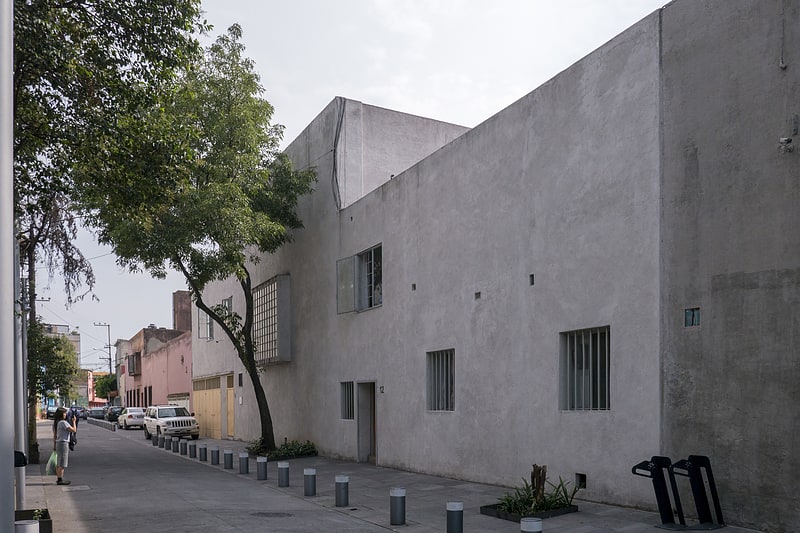
Also known as: Casa Luis Barragán
Luis Barragán's former home and studio. Luis Barragán House and Studio, also known as Casa Luis Barragán, is the former residence of architect Luis Barragán in Miguel Hidalgo district, Mexico City. It is owned by the Fundación de Arquitectura Tapatía and the Government of the State of Jalisco. It is now a museum exhibiting Barragán's work and is also used by visiting architects. It retains the original furniture and Barragán's personal objects. These include a mostly Mexican art collection spanning the 16th to 20th century, with works by Picasso, Diego Rivera, José Clemente Orozco, Jesús Reyes Ferreira and Miguel Covarrubias.
Located in the west of Mexico City, the residence was built in 1948 after the Second World War. It reflects Barragán's design style during this period and remained his residence until his death in 1988. In 1994 it was converted into a museum, run by Barragán's home state of Jalisco and the Arquitectura Tapatía Luis Barragán Foundation, with tours available only by appointment. In 2004, it was named a World Heritage Site by UNESCO because it is one of the most influential and representative examples of modern Mexican architecture.[14]
Address: Gral. Francisco Ramírez 12-14, 11840 Ciudad de México (Miguel Hidalgo)
Torre Latinoamericana
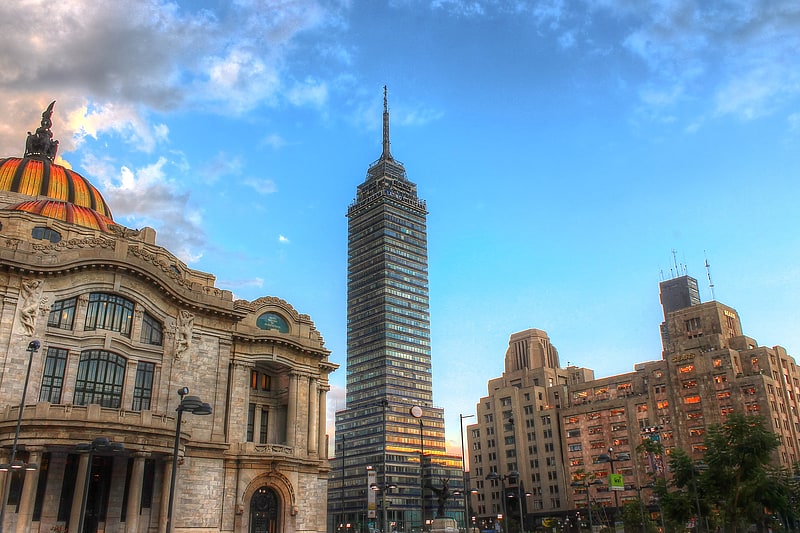
Skyscraper. The Torre Latinoamericana is a skyscraper in downtown Mexico City, situated in the historic city center. Its central location, height, and history make it one of the city's most important landmarks. It is widely recognized internationally as an engineering and architectural landmark since it was the world's first major skyscraper successfully built on highly active seismic zone. The skyscraper notably withstood the 8.1 magnitude 1985 Mexico City earthquake without damage, whereas several other structures in the downtown area were damaged.
The Torre Latinoamericana was Mexico's tallest completed building for almost 27 years, from its opening in 1956 until 1982 when the 214 m (702 ft) tall Torre Ejecutiva Pemex was completed. Although the structure of the Hotel de México (now known as the WTC Mexico City) had already surpassed it a decade earlier, it wouldn't be finished until 1994.[15]
Address: Eje Central Lázaro Cárdenas 2, 06007 Ciudad de México (Cuauhtémoc)
Chapultepec Zoo
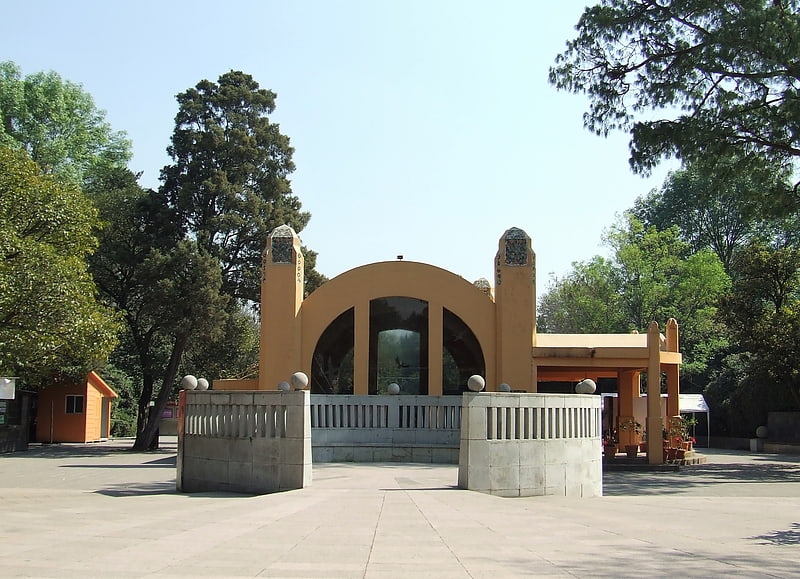
Also known as: Zoológico de Chapultepec
Zoo in Mexico City, Mexico. Chapultepec Zoo is a zoo located in Chapultepec Park; it is one of four zoos near Mexico City, and the best known Mexican zoo. It was founded July 6, 1923 by Mexican biologist Alfonso Luis Herrera using donations from private citizens and governmental funds from the Ministry of Agriculture and Development, and also with funds from the Society of Biological Studies.
The zoo houses almost 2000 animals from more than 200 species. The zoo is known for its success in breeding programs of threatened species, including: giant pandas (first institution outside of China to successively breed the species in captivity), California condors (first institution outside of the United States to successively breed the species) and Mexican wolves (first litter of cubs born to released wolves).[16]
Address: 1ª Secc. del Bosque de Chapultepec, 11000 Miguel Hidalgo (Miguel Hidalgo)
Our Lady of Guadalupe
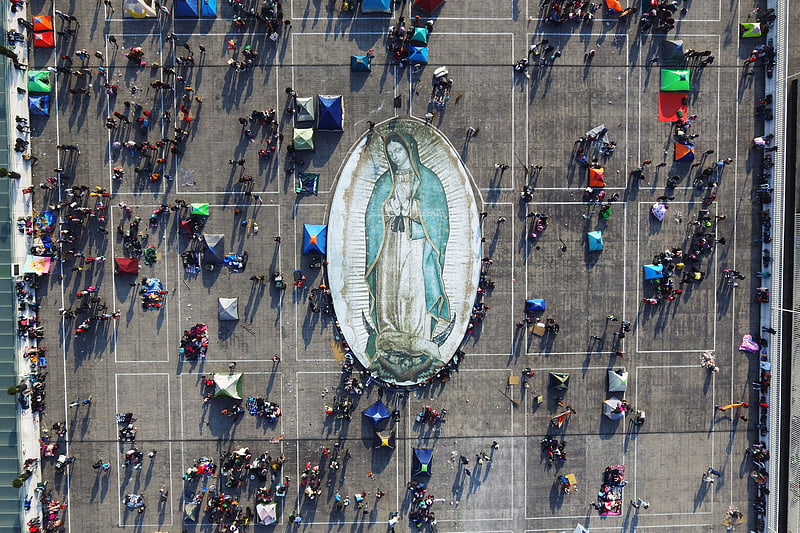
Also known as: Nuestra Señora de Guadalupe
Our Lady of Guadalupe, also known as the Virgin of Guadalupe, is a Catholic title of Mary, mother of Jesus associated with a series of five Marian apparitions in December 1531, and a venerated image on a cloak enshrined within the Basilica of Our Lady of Guadalupe in Mexico City. The basilica is the most-visited Catholic shrine in the world, and the world's third most-visited sacred site.
Pope Leo XIII granted the image a decree of a canonical coronation on 8 February 1887 and was Pontifically crowned on 12 October 1895.[17]
Tenayuca

Tenayuca is a pre-Columbian Mesoamerican archaeological site in the Valley of Mexico. In the Postclassic period of Mesoamerican chronology, Tenayuca was a settlement on the former shoreline of the western arm of Lake Texcoco. It was located approximately 10 kilometres to the northwest of Tenochtitlan.
Tenayuca is considered to be the earliest capital city of the Chichimec, nomadic tribes who migrated and settled in the Valley of Mexico, where they formed their own kingdoms.[18]
Address: Calz. Sta. Cecilia, 54152 Tlalnepantla
Colegio de Santa Cruz de Tlatelolco
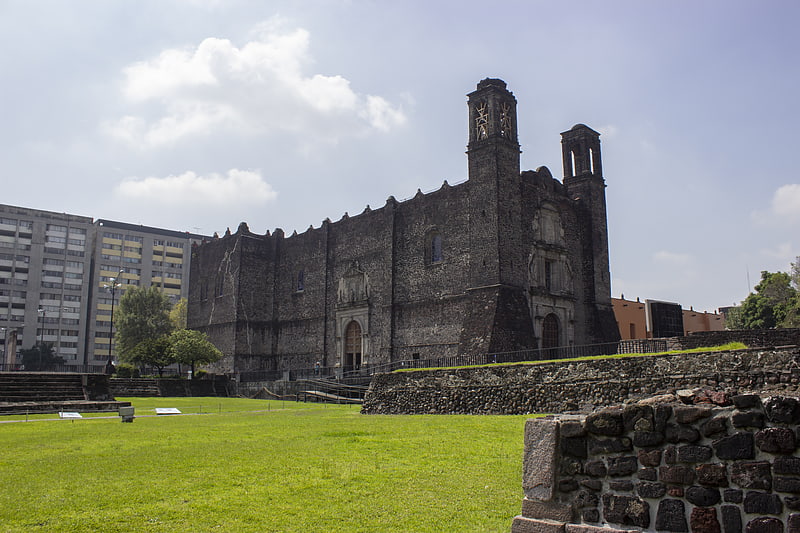
School in Mexico City, Mexico. The Colegio de Santa Cruz in Tlatelolco, Mexico City, is the first and oldest European school of higher learning in the Americas and the first major school of interpreters and translators in the New World. It was established by the Franciscans on January 6, 1536 with the intention, as is generally accepted, of preparing Native American boys for eventual ordination to the Catholic priesthood. Students trained in the Colegio were important contributors to the work of Franciscan Bernardino de Sahagún in the creation of his monumental twelve-volume General History of the Things of New Spain, often referred to as the Florentine Codex. The failure of the Colegio had long-lasting consequences, with scholar Robert Ricard saying that "ad the College of Tlatelolco given the country even one bishop, the history of the Mexican Church might have been profoundly changed."[19]
Basilica of Our Lady of Guadalupe
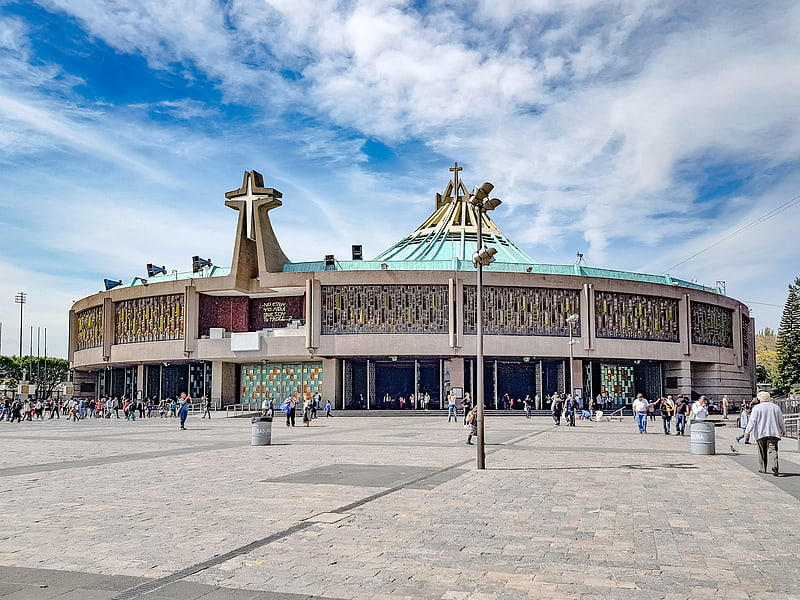
Also known as: Basílica de Santa María de Guadalupe
Basilica in Mexico City, Mexico. The Basilica of Our Lady of Guadalupe is a Roman Catholic church, basilica, and National shrine of Mexico which houses the cloak containing the image of Our Lady of Guadalupe. The 1709 shrine was built in the North of Mexico City near the hill of Tepeyac, where the Virgin Mary is believed to have appeared to Saint Juan Diego Cuauhtlatoatzin. The basilica structure which now contains Juan Diego's cloak was completed in 1974.
This site is also known as La Villa de Guadalupe or, in a more popular sense, La Villa, and has several churches and related buildings.
One of the most important pilgrimage sites of Catholicism, the basilica and tilma (cloak) are visited by several million people every year, especially around 12 December, Our Lady of Guadalupe's Feast day.[20]
Address: Plaza de las Americas 1, 07050 Mexico City (Gustavo A Madero)
Zócalo
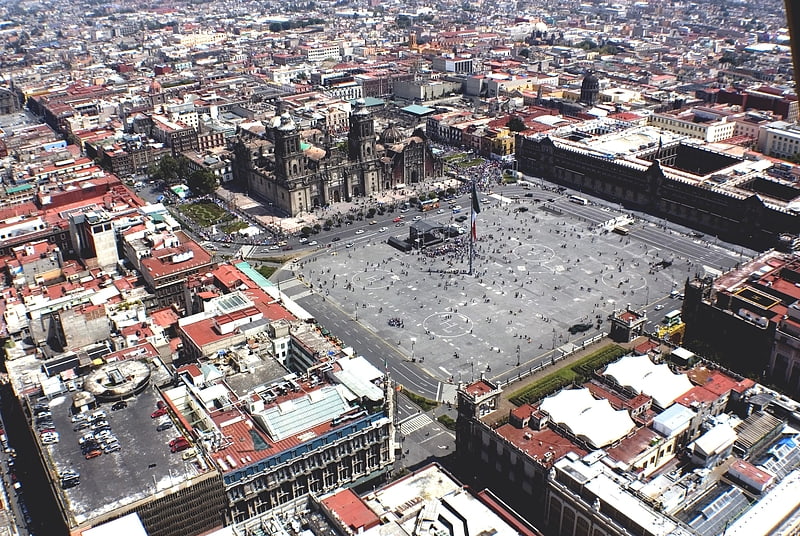
Also known as: Plaza de la Constitución
Prominent plaza with frequent events. The Zócalo is the common name of the main square in central Mexico City. Prior to the colonial period, it was the main ceremonial center in the Aztec city of Tenochtitlan. The plaza used to be known simply as the "Main Square" or "Arms Square", and today its formal name is Plaza de la Constitución. This name does not come from any of the Mexican constitutions that have governed the country but rather from the Cádiz Constitution, which was signed in Spain in the year 1812. Even so, it is almost always called the Zócalo today. Plans were made to erect a column as a monument to Independence, but only the base, or zócalo, was built. The plinth was buried long ago, but the name has lived on. Many other Mexican towns and cities, such as Oaxaca, Mérida, and Guadalajara, have adopted the word zócalo to refer to their main plazas, but not all.
It has been a gathering place for Mexicans since Aztec times, having been the site of Mexican ceremonies, the swearing-in of viceroys, royal proclamations, military parades, Independence ceremonies, and modern religious events such as the festivals of Holy Week and Corpus Christi. It has received foreign heads of state and is the main venue for both national celebrations and national protests. The Zócalo and surrounding blocks have played a central role in the city's planning and geography for almost 700 years. The site is just one block southwest of the Templo Mayor, which, according to Aztec legend and mythology, was considered the center of the universe.[21]
Frida Kahlo Museum
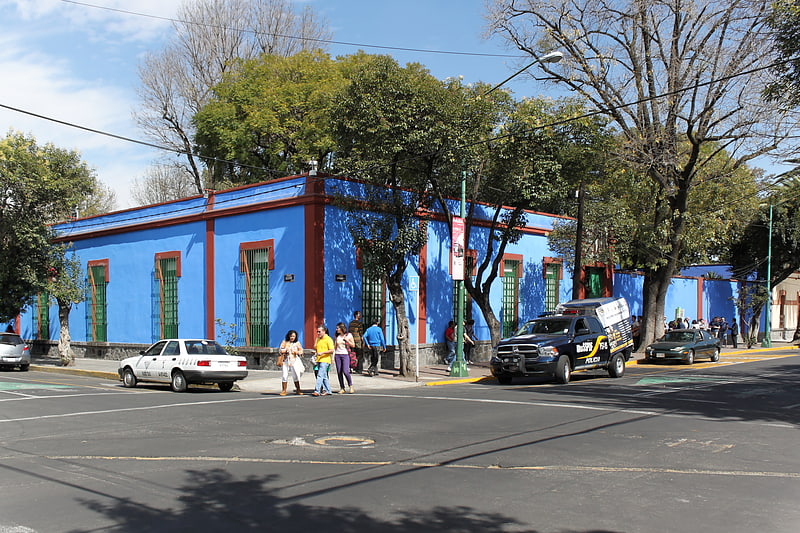
Also known as: Museo Frida Kahlo
Famous artist's home-turned-museum. The Frida Kahlo Museum, also known as the Blue House for the structure's cobalt-blue walls, is a historic house museum and art museum dedicated to the life and work of Mexican artist Frida Kahlo. It is located in the Colonia del Carmen neighborhood of Coyoacán in Mexico City. The building was Kahlo's birthplace, the home where she grew up, lived with her husband Diego Rivera for a number of years, and where she later died in a room on the upper floor. In 1957, Diego Rivera donated the home and its contents in order to turn it into a museum in Frida's honor.
The museum contains a collection of artwork by Frida Kahlo, Diego Rivera, and other artists along with the couple's Mexican folk art, pre-Hispanic artifacts, photographs, memorabilia, personal items, and more. The collection is displayed in the rooms of the house which remains much as it was in the 1950s. It is the most popular museum in Coyoacán and one of the most visited in Mexico City.[22]
Address: Londres 247, 04100 Ciudad de México
Mercado de San Juan
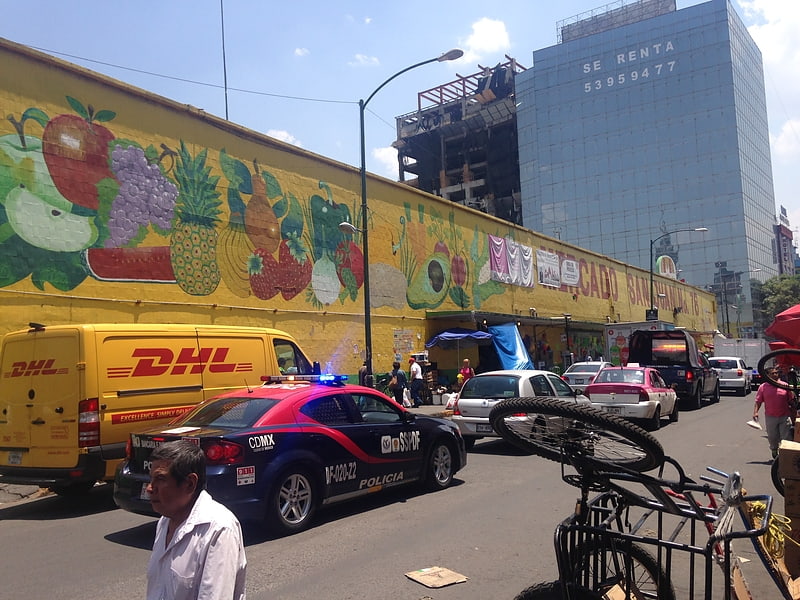
Market in Mexico City, Mexico. The San Juan Market is a traditional Mexican market in the historic center of Mexico City that has become the city’s only such market specializing in gourmet and exotic foods. It is known for its selection of exotic meats, including venison, crocodile, wild boar and even lion meat, as well as a wide selection of products from Europe and the Americas. Unlike other such markets in Mexico City, it caters to chefs, restaurateurs and foodies, many of whom are foreigners and have long-standing relationships with particular vendors.[23]
Address: 2ᵃ Calle de Ernesto Pugibet 77, 06000 Ciudad de México (Cuauhtémoc)
Monument to the Boy Heroes
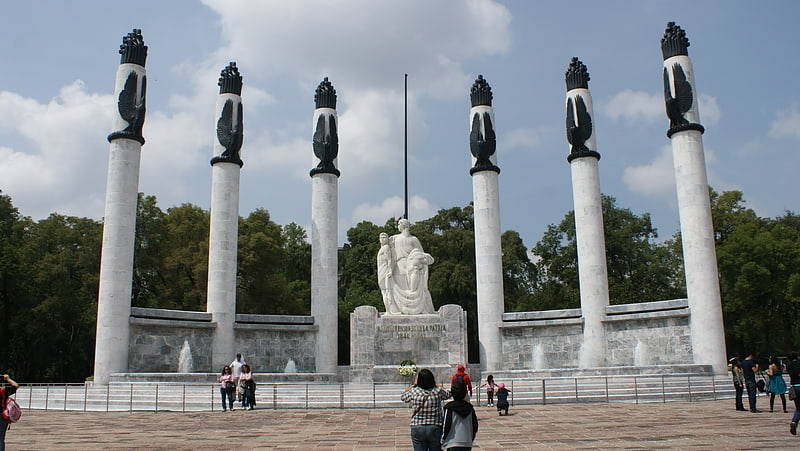
The Monumento a los Niños Héroes, officially Altar a la Patria, is a monument commemorating the Niños Héroes, installed in Chapultepec, Mexico City, Mexico.[24]
Address: Bosque de Chapultepec, 11560 Miguel Hidalgo (Miguel Hidalgo)
The Dark Knight Coaster
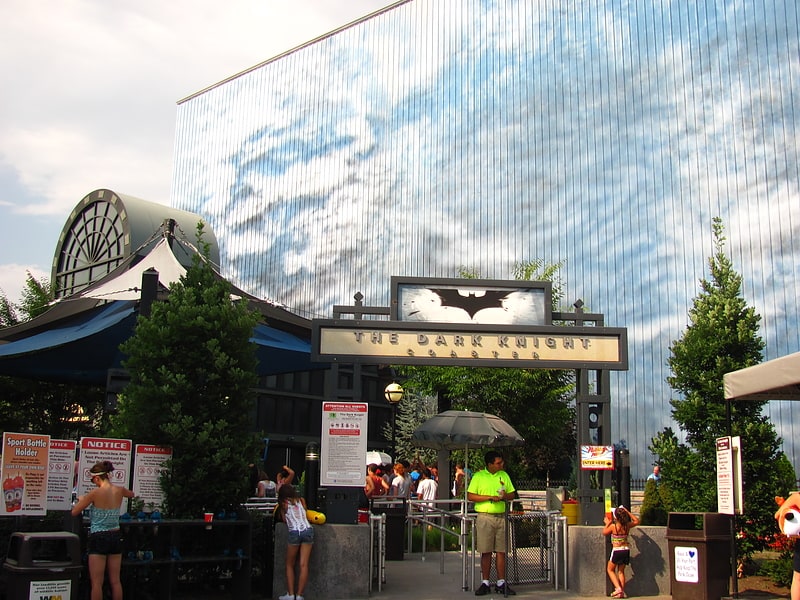
Roller coaster in Jackson Township, New Jersey. The Dark Knight Coaster is the name of three enclosed steel roller coasters located at Six Flags Great Adventure, Six Flags Great America, and Six Flags México. They opened in 2008 and 2009, timed closely to the theatrical release of The Dark Knight. All three installations were manufactured by Mack Rides.[25]
Address: Six Flags, 14200 Coyoacán
Boomerang
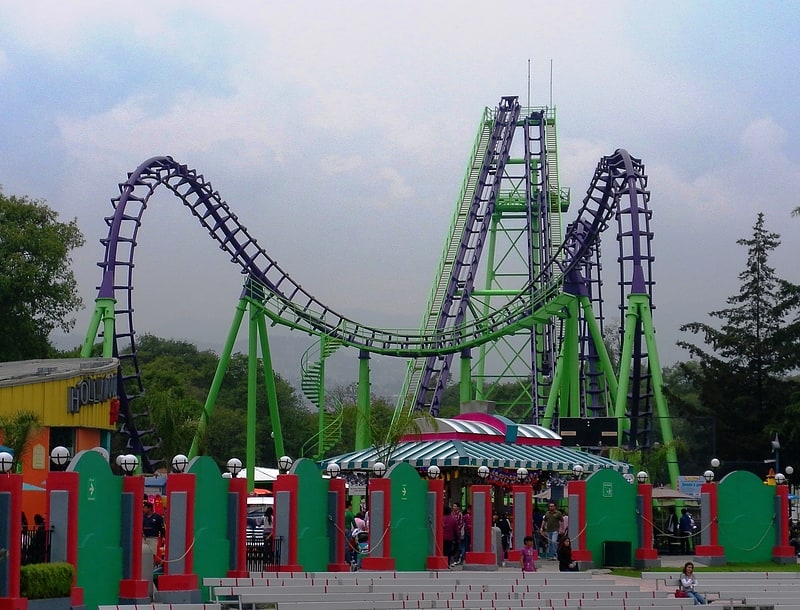
Roller coaster in Mexico City, Mexico. Boomerang is a Vekoma roller coaster currently operating at Six Flags México since 1988.[26]
Address: Six Flags, Mexico City
La Merced Market
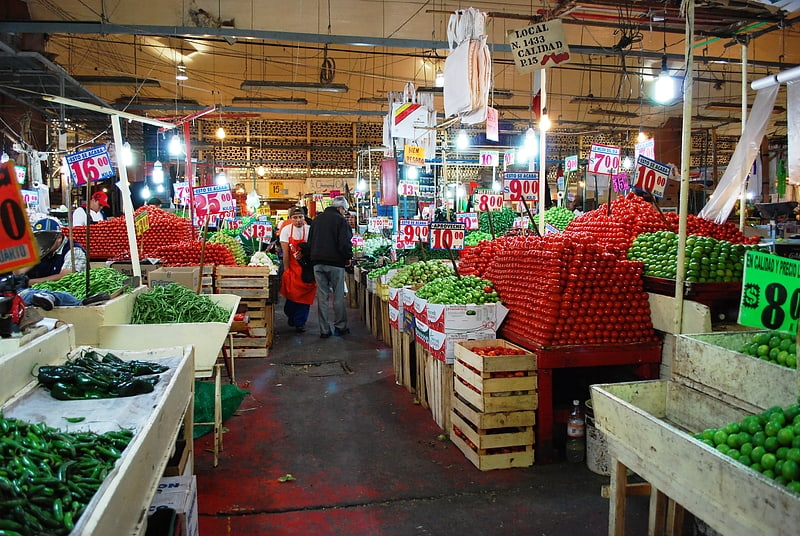
Also known as: Mercado de la Merced
Market in Mexico City, Mexico. The La Merced Market is a traditional public market located in the eastern edge of the historic center of Mexico City and is the largest retail traditional food market in the entire city. The area, also called La Merced, has been synonymous with commercial activity since the early colonial period when traders arrived here from other parts of New Spain. At one time, nearly the entire neighborhood was filled with market stalls and in the 1860s it was decided to build a permanent market on the grounds of the old La Merced monastery. In the first half of the 20th century, this market was the major wholesaler for the entire city. This ended when the Central de Abasto was opened in the 1980s, but La Merced remains the largest traditional retail market. The market area is also known for flagrant prostitution in which women can be seen soliciting at all hours of the day and night. It is estimated that about one third of these prostitutes are underage.[27]
Address: Anillo de Circunvalación, 15810 Venustiano Carranza (Venustiano Carranza)
La Casa de Madero
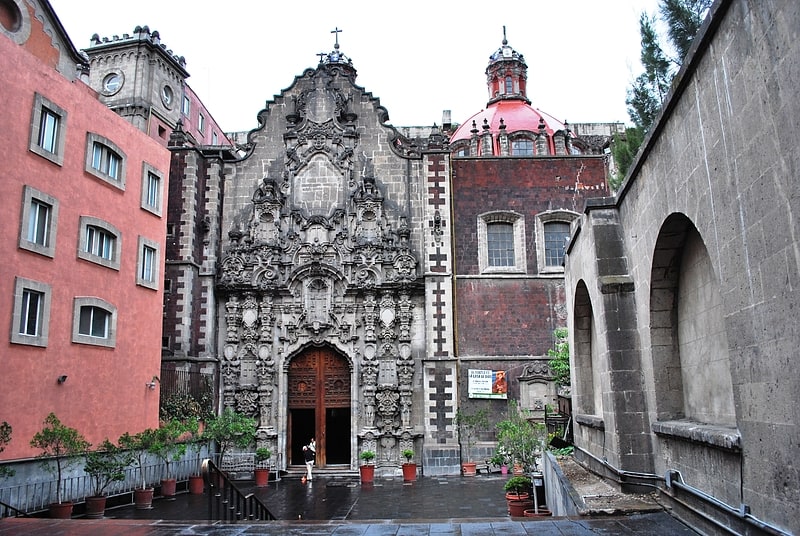
Also known as: Templo y exconvento de San Francisco
Catholic church in Mexico City, Mexico. The Convent of San Francisco is located at the western end of Madero Street in the historic center of Mexico City, near the Torre Latinoamericana and is all that remains of the church and monastery complex. This complex was the headquarters of the first twelve Franciscan friars headed by Martín de Valencia who came to Mexico after receiving the first authorization from the Pope to evangelize in New Spain. In the early colonial period, this was one of the largest and most influential monasteries in Mexico City. It was built on the site of where Moctezuma II’s zoo once was. At its peak, the church and monastery covered the blocks now bordered by Bolivar, Madero, Eje Central and Venustiano Carranza Streets, for a total area of 32,224 square metres.
In the patio of the first cloister, there was a cross that was reputedly taller than the highest tower in the city and made from a cypress tree from the “Chapultepec Forest”, meaning the forested area to the west of the Zocalo, where San Francisco was built.
The church and monastery saw a number of historic events in its time. A funeral mass for Hernán Cortés was here when it was thought that he died in Central America. In 1629, the Marquis of Gelves arrived in disguise to hide after quarreling with the archbishop. In 1692, the Count of Galve and his wife were granted refuge there due to a large-scale rebellion in the city. The end of the Mexican War of Independence was celebrated with a Te Deum at the monastery as the Trigarante Army of 16,000 troops marched past on Madero Street headed by Agustín de Iturbide. After the Reform War, the monastery of San Francisco, like many others, was disbanded and most of the property seized by the government. Much of the old monastery was demolished for the construction of new roads. Other parts of the old building are now a Methodist church facing Gante Street and a Panadería Ideal bakery. Where the bakery is now on 16 de Septiembre Street used to be the De Profundus Room, and the church is housed in the old cloister. On the corner of Venustiano Carranza and Eje Central are what used to be the Calvario and San Antonio chapels. These buildings still exist only because it was more expensive to demolish them than to leave them standing. All that is still left in church hands is the church itself.
The church standing today is the third to be built on the site. The first two sunk into the soft soil underneath Mexico City and had to be torn down. This church was built between 1710 and 1716. Although the entire building is known as the San Francisco Church, the entrance on Madero Street is actually the entrance to the Balvanera Chapel. In front of this is an atrium with several sets of stairs leading down to the church building because it, too, is sinking. The church’s main facade, dating from 1710, is walled in and cannot be seen. Entrance is now through the side door into the Balvanera Chapel, then into the main church. The facade of the chapel was constructed in 1766 and it is not sure who constructed it but most think it was the work of Lorenzo Rodríguez, best known for his work on the Metropolitan Tabernacle. The chapel’s statues were removed when the chapel was in the hands of an Evangelical sect, but it kept other decorative elements such as volutes, sculpted leaves and flowers and the estipite (inverted truncated pyramid) columns with medallions. Inside there is an 18th-century altarpiece dedicated to the Virgin of Guadalupe as well as the entrance to what was once the Chapel of the Second Station of the Stations of the Cross.
In the main church, there is a large gilded main altar, which is one that replaced the original Baroque one. This original one has been reconstructed because Neoclassic artist Jerónimo Antonio Gil left a drawing of it. Only the walls of the original De Profundis Room remain, the rest is remodeled into a bakery. The old cloister on Gante Street has fared a bit better. It is now a Methodist church, where inside both floors of the cloister have been well preserved. It can be visited only with prior authorization.[28]
Address: Calle Francisco i. Madero 7, 06000 Mexico City (Cuauhtémoc)
Medusa Steel Coaster

Roller coaster. Medusa Steel Coaster, formerly known as simply Medusa, is a steel roller coaster located at Six Flags México in Mexico City. Manufactured by Rocky Mountain Construction and designed by Alan Schilke, the ride opened to the public on 14 June 2014. It was originally a wooden coaster constructed by Custom Coasters International that debuted in June 2000. The wooden track was completely removed and replaced with RMC's I-Box track technology, a steel conversion that resulted in a new track layout with increased speed and the addition of three inversions. Medusa was generally well-received, ranking several times in the top 50 among steel roller coasters in the annual Golden Ticket Awards from Amusement Today.[29]
Address: Six Flags, Mexico City
The Joker
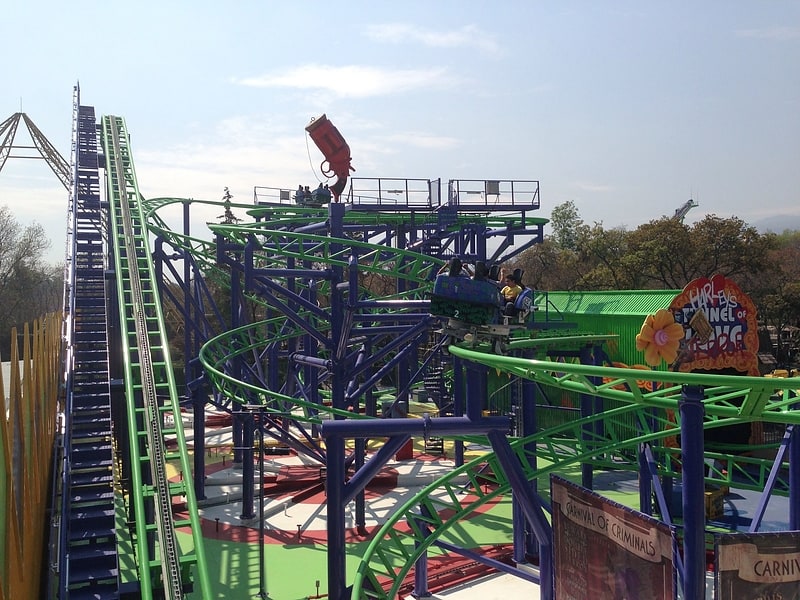
Roller coaster in Mexico City, Mexico. The Joker is a spinning roller coaster located at Six Flags México, a theme park in Mexico. The ride was designed by Gerstlauer and Werner Stengel. The Joker opened for the public on March 7, 2013.
The Joker's design consists of several cars holding four riders each. While the cars traverse the track, they spin around according to the angle of the track and the shifts in the riders' weight.[30]
Address: Six Flags México, Mexico City
Museo Franz Mayer

Decorative arts from the 1500s to 1800s. The Franz Mayer Museum, in Mexico City opened in 1986 to house, display and maintain Latin America’s largest collection of decorative arts. The collection was amassed by stockbroker and financial professional Franz Mayer, who collected fine artworks, books, furniture, ceramics, textiles and many other types of decorative items over fifty years of his life. A large portion comes from Europe and Asia but most comes from Mexico itself with items dating from the 15th to the 20th centuries. Many pieces in the collection are fine handcrafts, such as textiles and Talavera pottery, and they are important because they are items that often did not survive because most did not consider them worth preserving.
The museum is housed in the historic center of Mexico City in the former San Juan de Dios monastery and hospital, an 18th-century structure which was rehabilitated for the museum. In addition to displaying the items Mayer collected, of which only over a quarter is visible, the museum still makes acquisitions, hold workshops, sponsors temporary exhibits and has a café located in the center courtyard/garden.[31]
Address: Av. Hidalgo 45, 06300 Ciudad de México (Cuauhtémoc)
Palacio de Iturbide
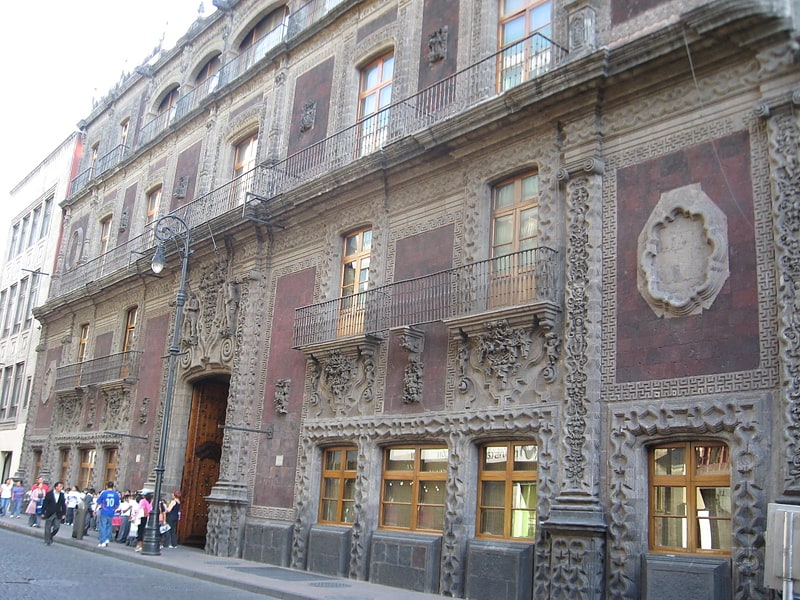
Baroque palace from the late 1700s. The Palace of Iturbide is a large palatial residence located in the historic center of Mexico City at Madero Street #17. It was built by the Count of San Mateo Valparaíso as a wedding gift for his daughter. It gained the name “Palace of Iturbide” because Agustín de Iturbide lived there and accepted the crown of the First Mexican Empire at the palace after independence from Spain. Today, the restored building houses the Fomento Cultural Banamex; it has been renamed the Palacio de Cultura Banamex.[32]
Address: Av Francisco I. Madero 17, 06000 Ciudad de México (Cuauhtémoc)
Plaza Tenochtitlán
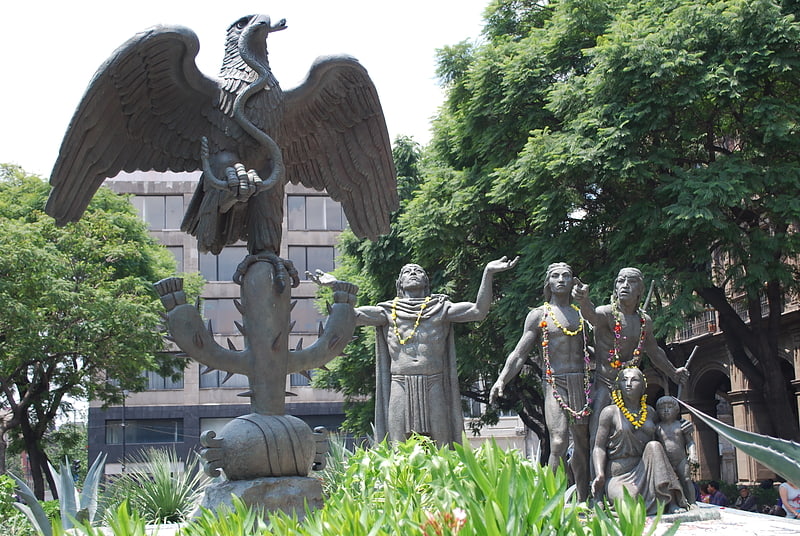
The Monumento a la Fundación de México-Tenochtitlán is installed near the government offices in the historic center of Mexico City, Mexico. The monument, designed by Carlos Marquina, was dedicated in 1970. Part of the sculpture depicts an eagle atop a cactus, eating a snake, similar to the imagery on the flag of Mexico.[33]
Museo Diego Rivera-Anahuacalli
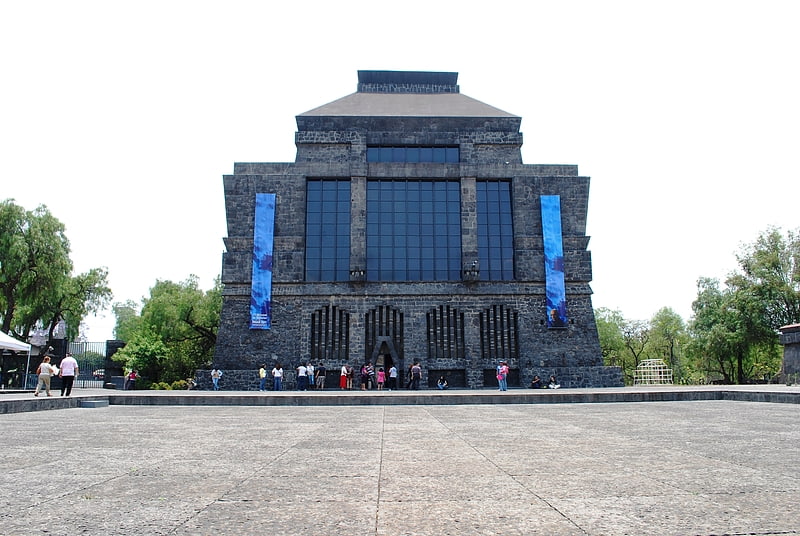
Also known as: Museo Anahuacalli
Grand museum with pre-Hispanic artwork. The Diego Rivera Anahuacalli Museum is a Museum and arts center, located in the San Pablo de Tepetlapa neighborhood of Coyoacán, 10 minutes by car from the Frida Kahlo Museum, as well as from the tourist neighborhood of this district.
The Anahuacalli (from the Nahuatl word, whose meaning is "house surrounded by water"), is a temple of the arts designed by the Mexican muralist Diego Rivera. This museum stands out for its extensive collection of pre-Columbian art, as well as for its Ecological Space that protects endemic flora and fauna. Rivera designed its architecture in order to safeguard his vast collection of pre-Hispanic pieces, while exhibiting the most beautiful works of this set in the museum’s main building. Accordingly, a selection of 2,000 artworks, especially well executed and preserved, has been on display since the opening of the Anahuacalli to the public on September 18, 1964.
The extravagant architecture of the building is inspired by Mesoamerican structures, with a unique style of its kind that mixes Mayan and Toltec influences mainly, although Rivera himself defined it as an amalgamation of Aztec, Mayan and "Traditional Rivera" styles. The Anahuacalli Museum building is erected with carved volcanic stone, extracted from the same place where it stands. According to the words of the Tabasco museographer and poet Carlos Pellicer (Tabasco, 1897-Mexico City, 1977), who designed the museum's permanent exhibition at the express indication of Rivera himself, the Anahuacalli responds to the following description:
“It is a personal creation using pre-Hispanic elements, mainly from Toltec architecture and some of the Mayan: sloped walls, serpentine pilasters and rhomboid doors. The pyramidal crown accentuates the magnificent character of the building.
The flat ceilings on the ground floor and the upper floors are decorated with original mosaics by the great painter, which are elements that are integrated into the architecture.
The ground floor is occupied by Aztec and the Teotihuacan artworks. A beautiful group of stone sculptures, clay figurines -models of temples- and pottery utensils.” Diego Rivera planned the Anahuacalli as a great stage for the development of diverse artistic expressions such as theater, dance, painting and music. These disciplines are immersed in an atmosphere whose architecture represents the search for the Mexican essence through its rich pre-Columbian past. At the same time, the Anahuacalli is integrated into the artistic, intellectual and educational events of contemporary times.
Every year, in compliance with the will that Rivera expressed for the Anahuacalli, contemporary art exhibitions are presented on the premises. These proposals are carefully chosen, as they must alternate harmoniously with the museum’s architecture, with the pre-Columbian art on display, with the nature that surrounds it, and with the foundational and evolving concept of Diego's Anahuacalli.
The Anahuacalli is a testimony to Rivera's generosity; he created a prodigious architectural work to display his collection of pre-Hispanic art with the people of Mexico and the world. Thanks to this Museum, today, thousands of national and foreign visitors can delve into the creative universe that the muralist left housed in this unique place. Everyone who visits the site can enjoy its natural and architectural spaces, as well as the rich collection of Mesoamerican art bequeathed to Mexico, by Master Rivera.[34]
Address: Museo 150, 04620 Ciudad de México
Museum of Mexico City

Also known as: Museo de la Ciudad de México
History museum housed in a former palace. The Museum of Mexico City is located at Pino Suarez 30, a few blocks south of the Zocalo, on what was the Iztapalapa Causeway, near where Hernán Cortés and Moctezuma II met for the first time. This building used to be the palace of the Counts of Santiago de Calimaya, who were the descendants of one of the conquistadors with Cortés. The house was extensively remodeled to much the appearance that it has today and remained in the family until 1960, when the Mexico City government acquired it from them in order to found the Museum that is found there today. The museum contains a number of elements of the old palace as well as 26 rooms dedicated to the history and development of Mexico City from Aztec times to the present. It also contains a library and the studios of painter Joaquín Clausell, who lived here in the late 19th and early 20th centuries.
The building was completed in 1779 and the descendants of the counts lived in it until 1960. The architect that completed the palace was Francisco Antonio de Guerrero y Torres.[35]
Address: José María Pino Suárez 30, 06010 Cuauhtemoc (Cuauhtémoc)